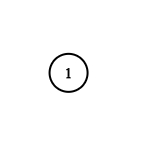133.Clone Graph (M)
https://leetcode.com/problems/clone-graph/
Given a reference of a node in a connected undirected graph.
Return a deep copy (clone) of the graph.
Each node in the graph contains a value (int) and a list (List[Node]) of its neighbors.
class Node {
public int val;
public List<Node> neighbors;
}
Test case format:
For simplicity, each node's value is the same as the node's index (1-indexed). For example, the first node with val == 1, the second node with val == 2, and so on. The graph is represented in the test case using an adjacency list.
An adjacency list is a collection of unordered lists used to represent a finite graph. Each list describes the set of neighbors of a node in the graph.
The given node will always be the first node with val = 1. You must return the copy of the given node as a reference to the cloned graph.
Example 1:

Input: adjList = [[2,4],[1,3],[2,4],[1,3]]
Output: [[2,4],[1,3],[2,4],[1,3]]
Explanation: There are 4 nodes in the graph.
1st node (val = 1)'s neighbors are 2nd node (val = 2) and 4th node (val = 4).
2nd node (val = 2)'s neighbors are 1st node (val = 1) and 3rd node (val = 3).
3rd node (val = 3)'s neighbors are 2nd node (val = 2) and 4th node (val = 4).
4th node (val = 4)'s neighbors are 1st node (val = 1) and 3rd node (val = 3).Example 2:

Example 3:
Constraints:
The number of nodes in the graph is in the range
[0, 100].1 <= Node.val <= 100Node.valis unique for each node.There are no repeated edges and no self-loops in the graph.
The Graph is connected and all nodes can be visited starting from the given node.
Solution
深度拷贝
表怎么存储:1.邻接表
Class Graph{
int node;
ArrayList<Node> neighbor;
}
2.邻接矩阵(矩阵里存点)
Version 1:BFS :时间复杂度O(n),空间复杂度O(n)
从原图给定的点找到所有点
复制所有的点
复制所有的边
HashMap里存放的是原节点和复制节点的对应关系,防止建立重复的新节点。
queue里存放原图节点的BFS遍历。
先复制一个头结点,将他们的map存进HashMap.然后头节点进入队列
每一次queue出列一个node,然后检查这个node对的所有neighbor,如果没有被visited,就产生一个新的复制节点并把们的关系放进map
然后建立这个复制关系的neighbor链表,将每一个neighbor的复制节点都放进当前复制节点的neighbor list.
与上面同一解法,在处理visited反过来
九章answer : http://www.jiuzhang.com/solutions/clone-graph/
http://www.cnblogs.com/springfor/p/3874591.html
Version 2:DFS(Time exceed)
Last updated
Was this helpful?